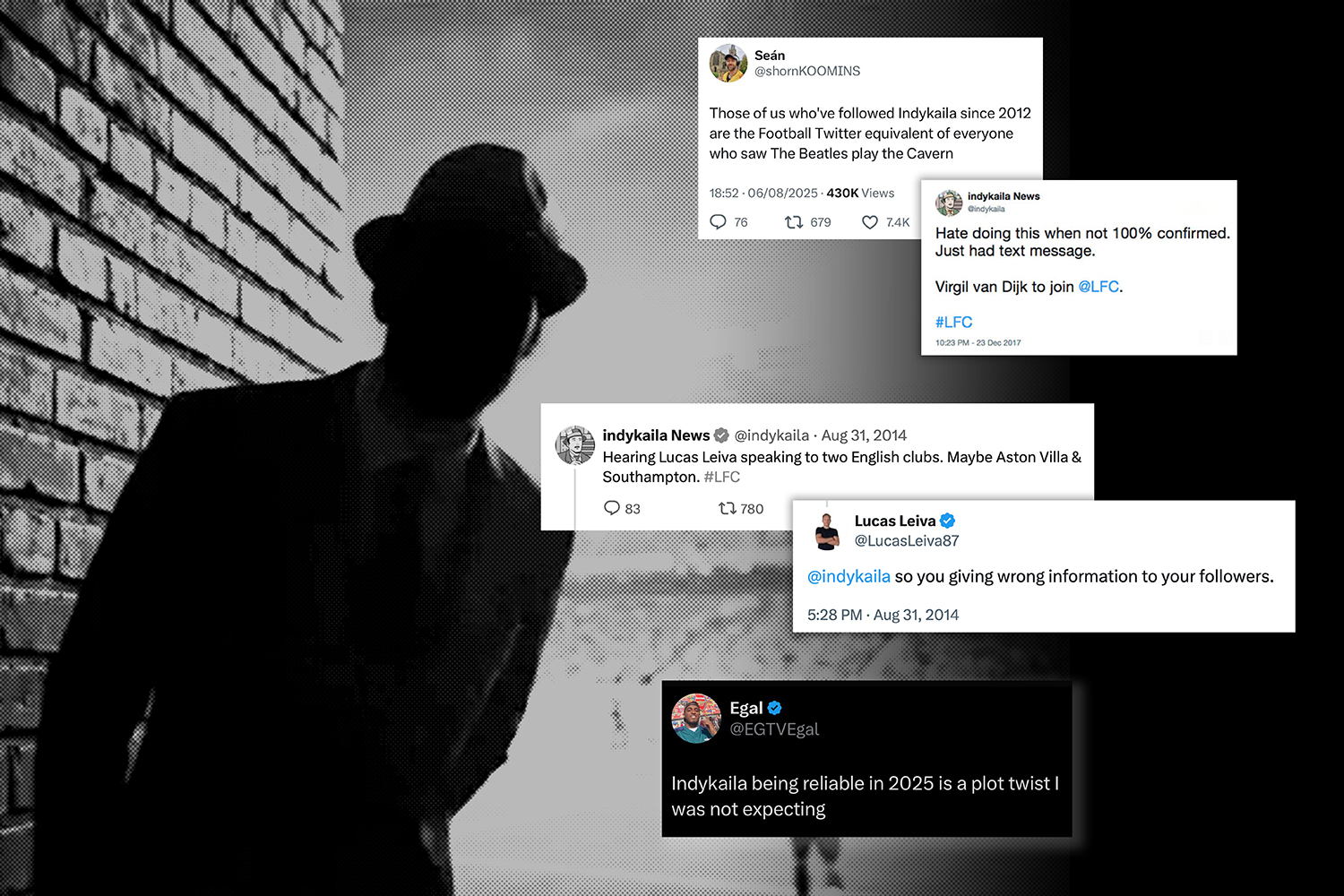Broadly speaking, football fans fall into one of two uneven groups. In group one are the vast majority, the millions of people whose interest in their team’s summer transfer activity is just a small part of a full, rich life. Maybe they idly check the BBC’s gossip column on their commute, or follow Fabrizio Romano on Instagram, or maintain a largely silent Twitter account. They do not spend time tracking private jets.
Group two is smaller, although its members still number in (at least) the hundreds of thousands. People in group two take a more active role in tracking their club’s recruitment. They are sufficiently invested in the transfer market that they are prepared to tolerate the endless crypto adverts, dubious claims about AI and obvious far-right grift that have come to characterise Twitter, now known as X.
If you are wondering which of these groups you might be in, there is a simple test. Last year, the etymologist Adam Aleksic suggested that “brainrot” words – terms like ‘skibidi’ and ‘gyatt’ and ‘rizz’, all of which are designed to appear nonsensical to outsiders – serve as cultural identifiers; using them is a way of detecting that a person is “chronically online”.
This week, the New Yorker writer Kyle Chayka took that argument and applied it to physical objects. The cornerstones of what he called the “IRL Brain Rot aesthetic,” things like Labubus and Matcha and Dubai Chocolate can all trace their popularity in some way back to memes; they are real world artefacts with digital roots. Engaging with them, he wrote, “is a way of testifying to how online you are, evidence you inhabit the same feed as your friends”.
This summer has provided an equivalent for internet football culture, still coalesced around the rotting carcass of Twitter. On 6 August, the Athletic journalist David Ornstein – the game’s foremost transfer reporter – tweeted a link to a story suggesting Manchester United wanted to sign Brighton’s Carlos Baleba. A moment later, he added an appendix. It read: “After @indykaila.”
If none of that makes any sense to you, if you don’t have the slightest idea who or what Indy Kaila might be, then you are in group one. If it does, then you are group two. In either case, it is worth exploring. Like Labubus, Dubai Chocolate and the word skibidi, Indy Kaila’s sudden transformation is a reminder that the membrane between online and the off is much more porous than it used to be.
Slightly inconveniently, the secret of Indy Kaila’s success is exactly what makes it so difficult to explain. The account’s popularity can, to some extent, be attributed to the fact that it has always occupied the hazy ground between the real and the fake. In some lights it looks like a spoof, at others a satire. It can be read both as a harmless pastiche – a sort of journalism cosplay – and as a deeply cynical hustle.
It pays, then, to start with the few things we can say with any certainty at all. The Twitter account @IndyKaila first came to life in May 2012. It was the brainchild of one person. He is from the Midlands. His name is not Indy Kaila. But, and this is a pretty good indication of where this is going, his name is also not not Indy Kaila. “It’s pretty close,” he said, when we spoke on the phone a couple of weeks ago. He will not reveal what it actually is.
He first came to prominence in an era when online football fandom centred on “ITK” culture: insiders (the acronym stands for “In The Know,” Group Ones) who would use forums, Reddit threads and then Twitter to leak information on clubs’ transfer targets, team news and dressing room politics.
By necessity, of course, these were all anonymous; because they were all anonymous, anyone could claim to be one. “I genuinely believe I was the first ITK,” Indy told me. This is, in all honesty, a bit of a stretch; a generous, if not entirely unreasonable, interpretation would be that his account was the first to claim to be In The Know on more than one club.
He did this, he said, in part by aggregating information he found elsewhere online and by offering his growing band of followers stories he had gathered from his own sources, friends who worked in clubs. Whether he did or not is difficult to say; it is not the done thing to ask even a self-appointed journalist to reveal their sources. Regardless, Indy did not especially care if any of the information he put out was correct.
His great love has always been transfer gossip; part of the fun of the subject, as far as he was concerned, was that it was basically impossible to tell if any of it was true. “I wanted the account to be like the Clubcall pages you used to get on Teletext and Ceefax,” he said. “You knew they were all bullshit, but you called them anyway. And then you got told off by your parents.”
Not everyone took the same view: his tweets were invariably greeted by dozens of replies calling him a fake, many of them (wrongly) alleging he worked in KFC. It did not stop him, though. In many ways, Indy Kaila is a relic of a more innocent social media age, a time when the mood on Twitter was more playful, more forgiving. Within a couple of years, he had a following that ran into six figures.
Nobody knew how seriously to take him, but it didn’t actually matter. “It’s pure gossip,” he said. “It helps that people don’t know if I’m real. Nobody expects me to get anything right. So there’s no damage to my reputation if something turns out to be wrong.”This summer, though, that has not proved to be an issue.
All of a sudden, over the last few months, Indy Kaila started getting things right.
In truth, it was obvious that something was different about Indy Kaila long before he was, in effect, graciously granted Ornstein’s seal of approval. So quickly does the online ecosystem churn that it is basically impossible to work out who broke which story first, but he was unusually bullish, early on, about Liverpool’s (still unrequited) desire to sign Alexander Isak and their interest in Jeremie Frimpong. He was also among the first to call Benjamin Sesko’s move to Manchester United.
There are varying interpretations of how this happened. Opinions on Indy Kaila within football journalism remain divided. One old friend (well, not that old) told me that it was not the sort of subject a serious newspaper would cover. Another suggested that Indy’s skill has always been his understanding of the innate rhythm most transfers follow, his ability to intuit a direction of travel.
Indy’s account is slightly different. He is now, he said, in a position to work with two freelance journalists to help with gathering his own reporting; although he still owns and operates the account, he mentioned he has received some “investment”. (He does not want to say whether it is now his full-time job or not; the mystery is too precious to him). This rings true: there has been a noticeable change in the tone and style of his tweets; it does feel, as a long-term Indy-watcher, as though it now speaks with more than one voice.
So, too, does his claim that in the last “18 months or two years” his network of sources has grown. He has not just established relationships with popular fan accounts – many of whom are well connected at the clubs they follow – but found himself contacted, with mounting frequency, by agents eager to tell him that one club or another is watching one of their players. His following is such that his reach can be a valuable tool not just in promoting a client’s name, but in negotiating a deal, too.
Whether Indy Kaila was legitimate at the start, in other words, is now not really relevant; he has, in effect, become the thing he was so often accused of pretending to be, the thing he maybe wanted to be all along. Chayka, in the New Yorker, cited the Brain Rot aesthetic that has come to define a generation as proof of Jean Baudrillard’s concept of hyper-reality, the point at which the simulation starts to feel more real than reality itself. He was talking about Labubus and Dubai Chocolate. Indy Kaila fits the bill just as well.
Composite image: @indykaila/Twitter (now known as X)

